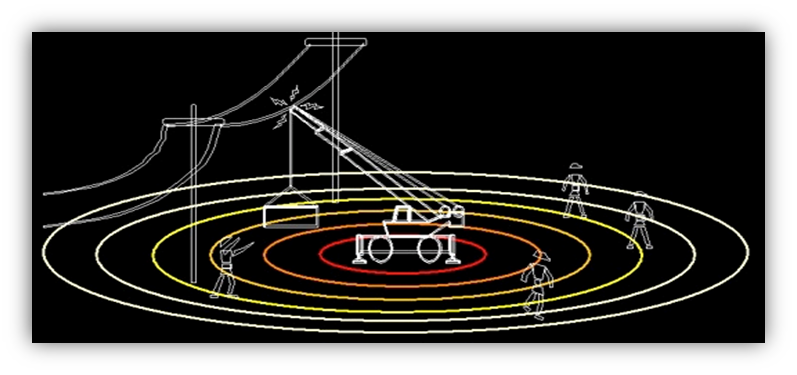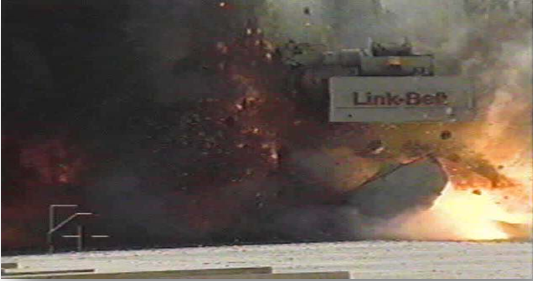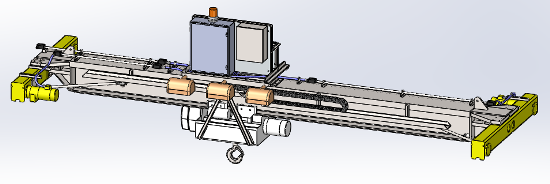Powerlines and Cranes – A Deadly Combination
It’s hard to imagine life without electricity. We flip a switch and things start working. It powers your lights, television, refrigerator, air conditioner and so much more.
Powerlines deliver electricity to our homes and offices and don’t seem dangerous because they are normally mounted up high and out of reach. The truth is, they have hundreds of times more energy than household currents.
Down on the ground we are usually pretty safe from the currents that run through powerlines. High reach equipment, however, is at risk. Cranes, backhoes, concrete pump trucks, fire department ladder trucks, and even news vans that have telescopic antennas can come in dangerous contact.
The Silent Killer
Electrocution is the number one crane accident in the world today, and has held that record for many years. Statistics show that powerline contact is 45% of all crane accidents. Almost all of them result in one or more fatalities.
How do these Accidents Happen?
Powerlines are hard to see when you are a pedestrian but even harder to see from a crane operator’s cab. They blend in and disappear into the landscape. When you do see them, it is impossible to judge how far away they are by eye. They are everywhere. Often you find them coming out of trees along roadways, industrial areas, in the cities and countryside. Often times, the operator knows they are present but is so busy running the crane, forgets they are there and swings into them. Very often the operators think they are further away or simply doesn’t respect the safe distance.
The Injuries
The electrical current enters the body at the point of contact with the power source, usually a hand or the head, and it travels through the body until it exits at the nearest point of ground, generally taking the most direct route. A person can be electrocuted either by direct contact with the power line, or indirectly, by touching something the power line contacts.
It’s important to understand the extreme electrical voltage from power lines. Typically, it’s between 4,800 volts and 13,200 volts. For comparison, the voltage used in the electric chair for death penalty situations was between 5,000 and 200 volts.
Accidents can be prevented
Deenergize and Ground
When working in proximity of power lines, the preferred condition is to deenergize and ground. Visually observe the grounding straps. They may not be close to or near the worksite, but take the time and go with the powerline owner and have them show you the grounding method.
Document a day and time for the outage. We have seen cases where the time was agreed on but the day was confused. The crane operator thought the power was off but it was the wrong day and a fatality occurred. Assume the lines are energized until you are assured, they are not. The power line owner must be present.
I often hear the argument that the power line owner cannot shut the lines down. In most cases, they can be deenergized but don’t expect to have it done in the same day as your request. The power company needs time to schedule the outage and/or reroute so as not to inconvenience their customers. It could take days or weeks, so plan ahead. On one of our projects, transporting a super high load, the transmission lines had to be raised by increasing the tower height. This took over a year to accomplish.
OSHA Addresses the Problem
OSHA put forth a complex rule to prevent power line contacts. It can be found at osha.gov. The rule was developed by the Cranes and Derrick Advisory Committee with the assistance of power line owners. These rules provide guidance, cover most situations and are easy to comply with.
The rule is 1926 Subpart CC – Cranes and Derricks in Construction, parts 1407 through 1411. Click on the links below to see the rules
- 1407 – Power line safety (up to 350 kV)—assembly and disassembly.
- 1408 – Power line safety (up to 350 kV)—equipment operations.
- 1409 – Power line safety (over 350 kV).
- 1410 – Power line safety (all voltages)—equipment operations closer than the Table A zone.
- 1411 – Power line safety—while traveling under or near power lines with no load.
The Table “A” Clearances
OSHA has published the minimum clearances shown in Table A. Do not violate these clearances without considering and complying with all parts of section 1926.1410
TABLE A—MINIMUM CLEARANCE DISTANCES
| Voltage (nominal, kV, alternating current) |
Minimum clearance distance (feet) |
| up to 50 over 50 to 200 over 200 to 350 over 350 to 500 over 500 to 750 over 750 to 1,000 over 1,000 |
10 15 20 25 35 45 As established by company |
Note: The value that follows “to” is up to and includes that value. For example, over 50 to 200 means up to and including 200kV.
If a Contact Occurs
- Stay in the crane and do not move around the crane.
- Don’t allow anyone to approach or touch the crane.
- The ground becomes energized and deadly
- If someone touches the crane the electricity will go through them to ground.
- If the crane catches fire and you have to leave:
- Jump off the crane and be sure not to fall back and touch the crane.
- Hop away from the crane – don’t run or walk. The ground becomes energized and dissipates in rings around the source of the ground.

If you walk or run away, you could have one foot in one ring of energy and the other foot in a different ring.
The electricity will equalize though you. Hopping away is the safest escape method.
- Do not approach the crane until the powerline owner says it is safe to do so. The owner’s representative must be there in person
A little-known fact is that the electric company computers sense a powerline contact as additional load and automatically increase power to keep up. It is as if 5000 homes turned on the AC at once.
Interestingly. If the crane is properly grounded, the computers see it as a fault and shut down the power. Unfortunately, the computers will try to restart multiple times so it is still not safe to approach or touch the crane until the powerline owner says it is safe to do so.

Crane Contacts 46,000-Volt Powerline

Energy Going to Ground Causes the Concrete to Explode

Electricity Going to Ground

Massive 46,000 Volt Arc Going to Ground

Crane Operator Escaped with Minor Injuries
Case Study – Layers of Protection
While repairing a power plant boiler on unit three of four in a row, we had to set up a crane with 200 feet of boom next to the turbine deck with energized 1000KV lines 100 feet on each side of the crane. When we asked to have the power shut down on units two and four the owner said it would cause a major power outage across most of the small southeastern state. In compliance with OSHA 1926.1410, we held meetings with the owner, the contractor, and the construction craft supervisors and came up with “layers of protection” to get the job done safely. The layers were inexpensive and easy to implement.
The layers included:
- Hard barricades 30 feet away from the power lines with spotters watching and directing the crane not to cross the line with any part of the crane or load. The barricades were marked with triangle shaped colored flags the full length to maximize visibility.
- Large orange balls were installed on the powerlines by the owner.
- Crane loads were brought in as needed and not stored anywhere near the barricaded area.
- An insulated link was installed on the crane hook.
- An electrical proximity warning device was installed on the crane and calibrated to alarm at a preset distance from the powerlines.
- A hard barricade was installed around the crane so no one could approach or touch the crane without permission from the operator and shift supervisor.
- Spotters were present 100% of the time to make sure no one approached the crane or violated the hard barricade.
- Rubber conveyer belting was placed around the crane to provide an insulated escape path for the crane operator in the event the crane and soil became electrified.
The job was completed without an electrical incident of any kind.
Additional Methods for Prevention
- Survey the work site and note locations of powerlines before bringing in the crane.
- Confirm the voltage of any powerlines in the work area of the crane. Make a call to the power company to confirm the voltage.
- Measure the distance from the maximum radius of the crane to the powerlines. Use a measuring tool. Don’t pace it off or guess. Refer to “Table A” for minimum distances.
- Note: If the “Table A” distances will be violated, contact the power company to arrange for lines to be deenergized. Draft a permit form to show the exact dates and times when the crane will be in close proximity to the lines. Have the crew and power company sign off. The power company technician must be present to entire time the crane is working in close proximity to the lines.
- Assign a spotter to communicate with the crane operator. The spotters shall have no other duties to distract them. Give the spotter and crane operator clear instructions for signaling.
- Meet with all responsible parties to develop layers of protection. Such as the layers discussed in the above case study. These layers are inexpensive and save lives.
- Hold pre-lift meetings to discuss the hazard, prevention methodology and discuss emergency procedures with everyone involved with the lift(s).
Powerlines are a silent killer and must be respected work around them must be well planned and executed. Becht can help you plan ahead, be prepared, and respect all safety procedures. Contact us prior to your next heavy lift.
Two videos showing powerline releasing massive amounts of energy below
1. Power running down the line (click)
2. Powerline Shorts out against a tree (click) Tree
If you have any questions about this article, please contact us.




